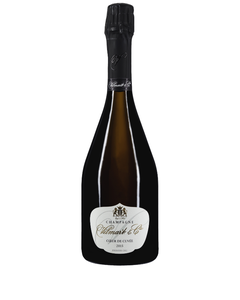Vintage - 2015, Champagne, Pin...
LIQUOR
Shop By
Champagne

The chalky soils of Champagne combined with its frigid growing environment create wines that are electric and salivating. But it’s the creation of bubbles that makes these wines stand out.
The bubbles are formed during a secondary fermentation in bottle, known as Méthode Traditionelle. The longer they age, the more nougat and brioche flavours develop and the finer the bead (bubble) becomes.
In terms of who invented Champagne, the English make a strong case as they worked out the formula for purposely making the fizz happen and their stronger coal-fired glass bottles - resulting from the Industrial Revolution - could hold the pressure. Whereas the French were still bottling in wood-fired glass which wasn’t strong enough and they hadn’t cracked the technique of creating bubbles on purpose.
Grapes
White: Chardonnay
Red: Pinot Noir, Pinot Meunier
Styles
Nowhere in the world can emulate the fineness and electric detail of these wines. Non-vintage Champagnes should be enjoyed earlier in their lives, while vintage wines have more structure and can age beautifully. House styles differ too. Blanc des Blancs (100% Chardonnay) offer a more elegant and fragile expression while Blanc des Noirs (100% Pinot and or Meunier) are darker fruited with more obvious structure and power.
Favourite Producers
Pierre Peters, Louis Roederer, Vilmart, Andre Clouet, Taittinger, Larmandier, Egly-Ouriet, Jacques Selosse
Show More...
-
 Vouette et Sorbee Blanc dArgile Brut Nature R18(R18, disgorged Nov 2020. Magnums R19, disgorged Dec 2021). Within the cold, west-facing, Kimmeridgian limestone-rich lieu-dit of Biaunes, there is a small plot of Chardonnay that Gautherot planted wild: without preparing the soils and amongst the native vegetation (a totally crazy idea). The Côte des Bar is overwhelmingly planted to Pinot Noir, but in 2000 Gautherot chose Chardonnay. He used massale cuttings from Anselme Selosse’s vines (in Avize) and Vincent Dauvissat’s Valmur Grand Cru vineyard. This plot has become the base of what Antonio Galloni calls “one of the most beautiful and distinctive wines in Champagne.”
Vouette et Sorbee Blanc dArgile Brut Nature R18(R18, disgorged Nov 2020. Magnums R19, disgorged Dec 2021). Within the cold, west-facing, Kimmeridgian limestone-rich lieu-dit of Biaunes, there is a small plot of Chardonnay that Gautherot planted wild: without preparing the soils and amongst the native vegetation (a totally crazy idea). The Côte des Bar is overwhelmingly planted to Pinot Noir, but in 2000 Gautherot chose Chardonnay. He used massale cuttings from Anselme Selosse’s vines (in Avize) and Vincent Dauvissat’s Valmur Grand Cru vineyard. This plot has become the base of what Antonio Galloni calls “one of the most beautiful and distinctive wines in Champagne.”
The vines here yield only 15 to 20 hl/ha each year—one of the keys to the intensity on offer. The 2018 and 2019 wines also took in some Chardonnay from Fonnet (from 2020, upcoming vintages will also take in Chardonnay from the Vouette vineyard, which was previously planted to Pinot Noir but was replanted to Chardonnay a number of years ago).
Fermentation for this wine was wild and took place in used 500- and 600-litre barrels, with a small portion of fruit fermented and raised in Georgian amphora (see Textures). As with the Fidèle, this wine spent roughly 15 to 18 months in bottle on lees, before being disgorged by hand with zero dosage.
2015Pinot noirFrance376$245.00 As low as $220.50 -
 Vilmart Coeur de Cuvee 201580% Chardonnay, 20% Pinot Noir from vines averaging 60 years old, the wine spends nearly 6 years on lees. Most importantly only the heart of the pressing is taken - 1400 litres instead of the usual 2100 litres, hence the name 'coeur de cuvee.'
Vilmart Coeur de Cuvee 201580% Chardonnay, 20% Pinot Noir from vines averaging 60 years old, the wine spends nearly 6 years on lees. Most importantly only the heart of the pressing is taken - 1400 litres instead of the usual 2100 litres, hence the name 'coeur de cuvee.'
The 2015 Brut Coeur de Cuvée is a pretty dense wine that belies its deceptively mid-weight structure. What surprises me most about the 2015 is how closed it is. In most years, especially warm years, Coeur de Cuvée is quite a bit more open and voluptuous, but the 2015 does not come across like that at all. Rather, it is super-classic in bearing, with tons of gravitas from the 60-year-old vines just waiting to emerge. There are none of the awkward herbal notes that penalize so many wines. Bright saline notes extend the finish effortlessly. The 2015 is a brilliant Coeur de Cuvée. ANTONIO GALLONI
2015chardonnay, Pinot noirFrance376$325.00 As low as $292.50

